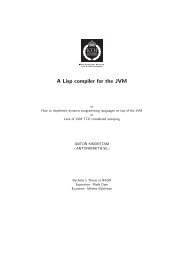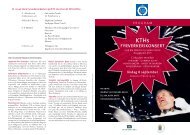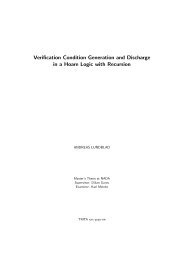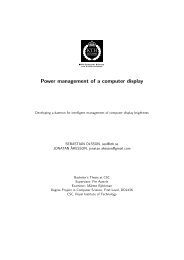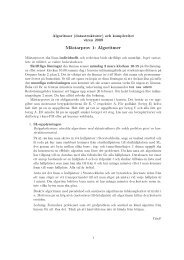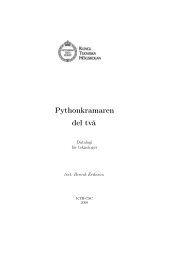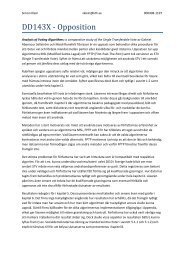The spectrum of delay-differential equations: numerical methods - KTH
The spectrum of delay-differential equations: numerical methods - KTH
The spectrum of delay-differential equations: numerical methods - KTH
Create successful ePaper yourself
Turn your PDF publications into a flip-book with our unique Google optimized e-Paper software.
2 Chapter 1. Introduction<br />
Some applications<br />
This generalization <strong>of</strong> the ODE is important, as it allows the mathematical treatment<br />
<strong>of</strong> models with <strong>delay</strong>s. Indeed, many physical events do not occur instantaneously<br />
and can be modeled with <strong>delay</strong>s. We mention some models with <strong>delay</strong>s<br />
from engineering, physics and chemistry.<br />
<strong>The</strong> electronic signal <strong>of</strong> the control <strong>of</strong> a robot takes some time to go from the<br />
controller to the robot arm. Similarly, if the controllers <strong>of</strong> the wing-rudders <strong>of</strong> an<br />
airplane are located in the cockpit, the controllers can only control the rudders<br />
with a certain <strong>delay</strong>. When a human driver on a high-way observes that the<br />
next car is breaking, he will hit the breaks after a certain reaction time. In the<br />
modelling <strong>of</strong> a high-way congestion, this reaction time influences the length <strong>of</strong> the<br />
congestion. Chemical reactions do normally not occur instantaneously. Suppose<br />
a manufacturer wants to produce a material with a customer specified material<br />
property. An (unpolluted) construction <strong>of</strong> a material with the given properties<br />
is sometimes only possible with an accurate control <strong>of</strong> the chemical process.<br />
Delays are also relevant in more critical applications. <strong>The</strong> accurate modelling<br />
and control <strong>of</strong> nuclear reactors is crucial. <strong>The</strong> temperature <strong>of</strong> the inner part <strong>of</strong><br />
nuclear reactor may not be available for measurement. If the temperature in the<br />
inner part rises, after some time (<strong>delay</strong>), the temperature <strong>of</strong> the surface <strong>of</strong> the<br />
reactor will also rise. Hence, only old information about the state is available for<br />
measurement and can be used to control the process.<br />
Since <strong>delay</strong>-<strong>differential</strong> <strong>equations</strong> appear in a large number <strong>of</strong> fields in science.<br />
It is not surprising that it has received different names in different fields. For<br />
instance, the following terms are used for slight variations <strong>of</strong> DDEs, time-<strong>delay</strong><br />
systems, difference-<strong>differential</strong> <strong>equations</strong>, retarded systems, functional <strong>differential</strong><br />
<strong>equations</strong> 1 .<br />
In particular, there are many results on DDEs in the field <strong>of</strong> control and<br />
systems theory, functional analysis, mathematical biology, <strong>numerical</strong> analysis<br />
and analysis in general.<br />
In this thesis we discuss results from several fields, but attempt a consistent<br />
presentation by using mostly the terminology and concepts <strong>of</strong> <strong>numerical</strong> linear algebra.<br />
In particular, we use the terminology <strong>of</strong> <strong>numerical</strong> <strong>methods</strong> for eigenvalue<br />
problems.<br />
1 DDEs is only one <strong>of</strong> many applications <strong>of</strong> functional <strong>differential</strong> <strong>equations</strong>.




